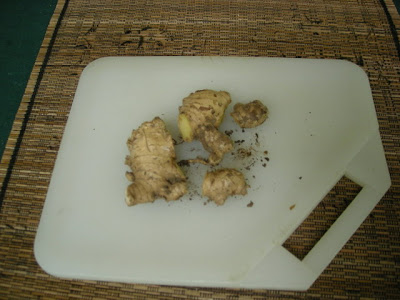
Look at this poor neglected and overgrown ginger!
It's saying: Eat me! Use me!
(Note: the large leaves are not from the ginger plant)
It's saying: Eat me! Use me!
(Note: the large leaves are not from the ginger plant)
Ginger is so easy to grow that anyone can do it. Really. Even if you aren't in a tropical climate, you can grow cooking ginger (Zingiber officinale) over a long summer in southern areas of the US, or in a pot in a sunny window if your summers are short. First Mate can probably even grow it on her sailboat. A bonus is that it has an attractive, bamboo-like foliage.
 Buy some nice fresh ginger root (actually a rhizome, not a root) at the grocery store. Skip those shriveled pieces. You are going for the bigger plump pieces. Cut the rhizome into pieces of an inch or two (2.5 to 5 cm.). I usually cut the nodes apart in the natural sections in order to have less cut surface. The pieces can be any size but you probably will get a quicker show with a larger 2 inch piece.
Buy some nice fresh ginger root (actually a rhizome, not a root) at the grocery store. Skip those shriveled pieces. You are going for the bigger plump pieces. Cut the rhizome into pieces of an inch or two (2.5 to 5 cm.). I usually cut the nodes apart in the natural sections in order to have less cut surface. The pieces can be any size but you probably will get a quicker show with a larger 2 inch piece. Let the cut ends dry out for a day or two on newspapers before planting in the ground or in an 8-12 inch pot (20-30 cm.). Azalea pots (wider than they are tall) are good because ginger doesn't have a deep root system. Two or three pieces are enough for a pot.
Let the cut ends dry out for a day or two on newspapers before planting in the ground or in an 8-12 inch pot (20-30 cm.). Azalea pots (wider than they are tall) are good because ginger doesn't have a deep root system. Two or three pieces are enough for a pot.Plant the callused ginger pieces so they are only about half covered by soil. Water in and keep moist until the roots form. My organic gardening book says that ginger should be fed three times per year, but look at mine and it has never been fertilized except for a couple of sprinklings with compost.
If you are starting ginger this time of year in a non-tropical climate, it's best to start it and keep it in a pot over the winter. Cut back on the watering during the cooler months. Plant it outside next summer or just transplant to a larger pot. It will generally grow to about 18-24 inches tall (46-60 cm).
 Ginger will grow in sun or shade, but semi-shade is best. It doesn't like temperatures below 50°F (10°C). Harvest by cutting off the nodes with a sharp knife as you need them, leaving the rest of the plant. The original plants will continue to grow and produce more ginger 'hands.'
Ginger will grow in sun or shade, but semi-shade is best. It doesn't like temperatures below 50°F (10°C). Harvest by cutting off the nodes with a sharp knife as you need them, leaving the rest of the plant. The original plants will continue to grow and produce more ginger 'hands.'In Spanish, ginger is jengibre, pronounced hen-he'-bray. Notice how close that is to the Latin name Zingiber.
Ginger root is used in cooking as well as for medicinal uses. I use it in Oriental recipes and we especially like it to flavor pork chops. I also make a tea with lemon and ginger when El Jefe gets a cold.
Ginger is said to prevent motion sickness, so those of you taking the ferry (sometimes called the vominator or the vomit comet) to or from the Bay Islands might want to chew a piece before you go. I'd love to know if that works, so let me know.
Ginger is also said to be an important antioxidant, good for treating inflammation, arthritis, and stomach upsets, and may even help to reduce cholesterol. A friend even sent me a recipe for a ginger compress that is said to help with carpal tunnel syndrome. Even doctors believe in it, see the University of Maryland Medical Center's impressive listing of medicinal uses for ginger.
A little ginger goes a long way, so it's handy to have your own to harvest as you need it rather than having to run to the grocery store when you need a one inch piece of ginger for a recipe. If you have cut more than you need, one of the best ways that I've found to store ginger is to wrap it in a damp paper towel and keep it in the veggie drawer of the refrigerator. That seems to provide just the right amount of humidity to keep it fresh for a longer period. Or, just let it dry out and replant the excess piece. That's recycling.
I'm thinking of crystallizing some of my excess ginger.


 Welcome to my Blogicito —
Welcome to my Blogicito — 







